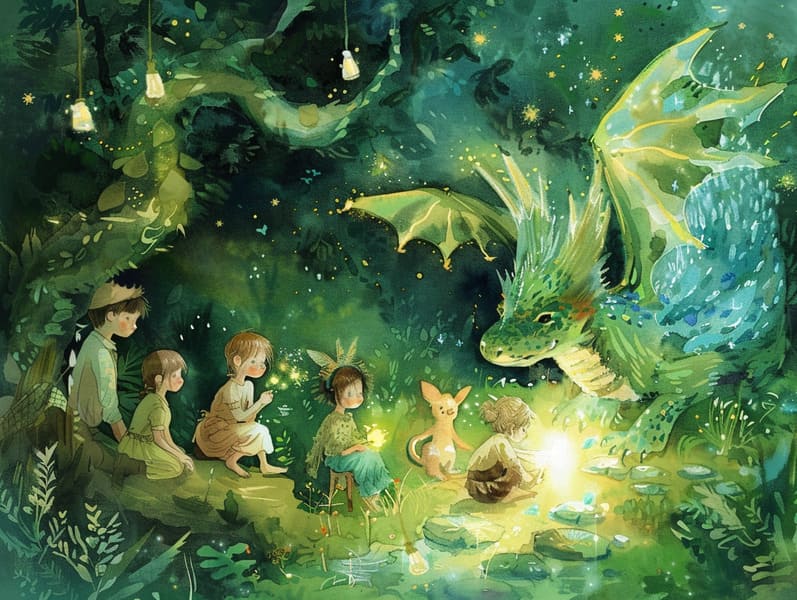
Classic fairy tales have long histories. These tales have been passed down from one generation to the next well before they were ever published. They sprang from a variety of civilizations, including Indigenous traditions. They were initially narrated among older generations, often carrying themes and messages mirroring the societal norms and beliefs of the time.
The Grimm brothers, Jacob and Wilhelm (the Grimm brothers), were among the first to gather and publish many of these beloved narratives. Their published works, "Grimm's Folk Tales," included stories like "The True Bride," "Hansel and Gretel," and "Snow-White and Rose-Red," which have since become classics in the world of timeless fairy tales. Similarly, Hans Andersen's enchanting tales, such as "The Sea Maid," and "The Story of the Ugly Duckling," have floated into hearts worldwide, ensuring their place in the pantheon of timeless fairy tales.
Though they are centuries old, fairy tales remain as applicable as ever, especially as children's night stories. These whimsical stories are now available in diverse formats, including vibrantly illustrated books, charming animations, and digital storybooks.
Their persistent charm can be credited to several enchanting factors:
Crucial Morals: Old fairy tales often whisper important moral lessons. Stories like "The Shepherd Boy and the Wolf" teach the significance of honesty, while "The Race of the Tortoise and the Hare" stress the qualities of steadfastness and humbleness. These tales offer the young clear distinctions between correct and incorrect, helping to shape their moral compass in a tender yet lasting way.
Compassion and Knowledge: Classic fairy tales frequently involve characters facing challenges and problems, prompting young listeners to feel with their struggles and applaud their triumphs. For instance, "The Tale of Beauty and the Beast" shows us the virtue of valuing inner qualities to recognize the true nature of a soul, nurturing warmth and comprehension.
Cultural Insights: Many ancient fairy tales are deeply embedded in the cultural contexts from which they came. Learning from these narratives can provide captivating looks into different backgrounds, strengthening a sense of world insight and appreciation.
Creativity and Fantasy: The fantastical elements in classic fairy tales—talking beasts—fire up children’s dreaming abilities. These tales take readers to enchanted realms, provoking inventive ideas and a sense of fascination that continues a lifetime.
Traditional fairy tales are not only mesmerizing but also educational. They provide captivating tools in building various intellectual and emotional capacities in little ones. When ancient fairy tales are narrated, they boost verbal development by offering new terms and sophisticated sentence structures. This practice also promotes listening skills and focus, as young ones follow the story, prepared to see what happens next.
Furthermore, conversing about the themes and characters of classic fairy tales can sharpen logical thinking and critical thinking. The young are taught to identify patterns, expect results, and make sense of cause and effect. These analyses also advance young ones communicate their thoughts and feelings, enhancing their emotional intelligence.
In today’s digital age, the presence of digital fairy tales has made these narratives more accessible than ever. Web-based platforms and digital apps present wide arrays of timeless fairy tales that can be accessed or heard anytime, anywhere. Fairy tales voiced are particularly liked, presenting an delightful method for the young to savor these mesmerizing stories. Sound books and read-out-loud stories take characters and settings to life, often augmented by magical melodies and background music that elevate the storytelling journey.
The persistent attraction of timeless fairy tales lies in their ability to change to modern days while continuing with their main lessons. Contemporary revisions of these narratives often incorporate more multicultural figures and modern settings, making them pertinent to today’s audience. However, the underlying themes of heroism, sympathy, and even-handedness remain unchanged, continuing to impact listeners of all ages.
Old fairy tales also offer a sense of familiarity and comprehensibility. They supply a orderly narrative with a distinct beginning, middle, and end, often wrapping up with the termination of conflicts and the triumph of righteousness over wickedness. This uniformity can be heartening for children, extending a sense of reliability in an constantly changing world.
Classic fairy tales continue to charm and guide new generations, maintaining their allure and applicability in modern society. As children's night stories, they provide a perfect blend of fascination and comprehension, fostering moral values, empathy, and creativity. The existence of web-based fairy tales and the in demand status of fairy tales voiced make sure that these timeless narratives remain obtainable to new generations.
By retaining and releasing these narratives, we continue to extol the rich tapestry of legends and get more info cultural heritage. Whether you are accessing a gorgeously illustrated book, discovering a internet library, or playing an spoken story, the delight of old fairy tales is always within reach. These fairy tales show us of the timeless ability of stories and its ability to tie us across generations and cultures.
If you are perusing a vibrantly illustrated book, perusing a web-based library, or hearing an sound book, the fascination of bedtime fairy tales is always within reach.
These narratives highlight of the continued impact of narratives and its ability to bond us across eras and regions, casting a charm that delights and instructs alike.